University study declares a “new” golden ratio for facial beauty but validates Phi, the Golden Ratio, as the basis for perceptions of beauty.

A university study (PDF) by Pamela M. Pallett, Stephen Link and Kang Lee at the University of Toronto and University of California, San Diego announced that a “new” golden ratio had been found in perceptions of beauty in the human face. The study also said there was “little support for the Golden Ratio” that “dates back to antiquity, when the ancient Greeks believed beauty was represented by a Golden Ratio of 1:1.618.” Science Daily, in reporting on this study, quoted the one of the researchers as saying “People have tried and failed to find these ratios since antiquity” and “there was never any proof that the golden ratio was special. As it turns out, it isn’t.”
But all that glitters isn’t gold …
With this article, I think you’ll agree that the search is over, the proof exists and the real Golden Ratio is still quite special. Ironically, the results of the 2009 university study actually support this. The proof and significance of the Golden Ratio in the facial attractiveness is revealed with a simple illustration of twelve true Golden Ratios that appear in the proportions of all the key facial markers of their own ideal model:
Vertical golden ratios:
White – Hairline : Eyebrow top : Eye top
Gold – Eyebrow top : Eyebrow bottom : Eye top : Eye bottom
Blue – Eye pupil : Nose flair : Nose bottom
Green – Eye pupil : Nose bottom : Mouth
Green – Eye pupil : Nose bottom : Chin
Green – Eye pupil : Mouth : Chin
Horizontal golden ratios:
Gold – Face side : Eyebrows : Face side
Gold – Face side : Eye inside : Face side
Gold – Face side : Nose width : Face side
White – Face side : Eye outside : Nose center
Blue – Eye outside : Eye inside : Nose center
Green – Mouth outside : Lip cupid’s bow : Mouth outside
Each of the above colored rectangles is divided at its golden ratio point, accurate to the pixel and created with PhiMatrix, a golden ratio analysis and design application.
The conclusions of the study run contrary to evidence presented on this site since 2001 and its predecessor site for longer yet. The 2009 study was successful in identifying an attractive face, but the researchers apparently didn’t realize that their ideal faces contained numerous true Golden Ratios based on 1.618 and that their “new” golden ratios were simply mathematical derivations of 1.618. While this was not their intent, the study actually provided very good evidence for the validity and significance of the appearance of the true Golden Ratio of 1.618 in our perceptions of beauty in the human face, as illustrated on the Beauty and the Golden Ratio page.
Isn’t there more to beauty than two simple measures?
The study also made a critical but highly questionable assumption that human facial attractiveness is defined by two very simplistic measures:
- Vertical dimension – The distance between the pupils and mouth (AB) in relation to the distance of the hairline to the chin (CD), and
- Horizontal dimension – The distance between the pupils (EF) in relation to the width of the face (GH).
Why is it that women known for their beauty fail to measure up?
The researchers noted in one interview, “Angelina Jolie does not have golden length and width ratios. Elizabeth Hurley gets the golden ratio for length but is different from the width golden ratio by one per cent. But Canadian country pop musician Shania Twain has “both the length and width ratios.” Florence Colgate, voted in 2012 as having the most beautiful face in Britain, also failed to meet both metrics.
Is the “new” golden ratio wrong or incomplete?
So this begs this question: If women known for their beauty fail to measure up to this “new” golden ratio, could it be the metric that’s wrong? That’s actually quite easy to prove. With apologies to the pretty young lady whose face was digitally altered in the study to create their ideal attractive face, below are two digitally altered images that make her somewhat less attractive:
Despite these distortions, these faces still retain the two “new” facial proportions that the study claims to define attractiveness. The “pupil to face width” and “eye-mouth to hairline-chin” ratios are identical to those in their original ideal photo. All that was changed in the distorted photo were the eyebrows, nose and size of the lips.
The photo below retains identical sizes of every facial feature in the original .36 photo, as well as all the eye-mouth-face ratios that the study said were critical to attractiveness. Just one change was made. In the photo on the right, the positions of the eyes and mouth were shifted down by 20 pixels, with very unfavorable results on her attractiveness. This demonstrates that many other facial proportions not identified by the study are also critically important to attractiveness.
If we were to accept their two “new” golden ratios as all there is to beauty, the study would have you believe that the distorted faces should be just as attractive as the unaltered faces. And, because these distorted faces still conform to their two “new” golden ratios, the distorted faces should also be just attractive as Shania Twain and more attractive than Angelina Jolie, Elizabeth Hurley and Florence Colgate. This clearly isn’t the case, so the “new” golden ratios must not be capturing all the factors that truly define beauty. As a result, one cannot use the conclusions or “new” ratios of the 2009 to make valid assessments of relative attractiveness. A more scientifically valid approach would have been this:
- Base the study on dozens of photos of different attractive woman rather than creating digital distortions of a single woman who, while pleasantly attractive, probably would not be regarded by most to be as strikingly beautiful as Jolie, Twain, Hurley, Colgate or others.
- Have participants in the study rank the dozens of different women in order of beauty.
- Examine the photos of women ranked highest in beauty to find all the common characteristics in facial features that they all share.
Dr. Stephen Marquardt, inventor of the patented Marquardt “Beauty Mask“, is a noted plastic surgeon and recognized expert on beauty who has been referenced in hundreds of magazines, TV shows and documentaries. In an interview, Dr. Marquardt stated that the hairline is one of the most variable features on the human face and not a meaningful benchmark at all for beauty. He also commented that the width of the face is not a critical metric either. Beauty is the combination of golden ratio proportions in many facial markers, the most important of which are the positions, shapes and proportions of all aspects of the eyes, nose, mouth, chin and eyebrows.
How did the study find the Golden Ratio but not see it?
As illustrated at the top of this article, the face selected in the study as the most attractive has a significant number of facial proportions that illustrate the true golden ratio, 1.618. How did the researchers not see it? Perhaps not having the right tools or understanding of the Golden Ratio in facial proportions, but also because their “new” golden ratios are just mathematical variations on the true golden ratio.
- The “new” vertical golden ratio of 0.36 is close to 0.38, which is simply the golden ratio reciprocal variation of 1/1.618 squared. Their vertical ratio of 0.36 varies from this, but was based on the hairline at the top of the forehead, which is a highly variable feature in the human face.
- Their “new” horizontal golden ratio of 0.46 is close to 0.47, and is simply the measure that results when using the pupils rather than the inside and outside corners of the eyes, which are often based on golden ratio relationships to the width of the face. The small difference that does exist in this ratio from the pure golden ratio proportion is not visually significant, and may also be explained by the fact 0.47 was not offered as a choice in the study. In addition, the facial photo used in the study was very asymmetrical, with the left half of the face being about 8% wider than the right half. This alone created a possible range of +/- 0.037 on the ideal horizontal ratio of 0.47.
By analogy, think of it this way: A study announces a “new” 4 inch measure for the foot has been found, and says there is little “little support for the foot that dates back to antiquity, when people believed that a foot represented a measure of about 12 inches. The researchers say “Many have tried and failed to find people with a 12 inch foot” and “there was never any proof that the 12 inch foot was special. As it turns out, it isn’t.” The study presents the “new” foot measurement of about 4 inches, but when you look deeper you find that they were measuring the width of the foot rather than its length. It’s not entirely wrong, but it certainly isn’t right.
The methodology of measuring and calculating the “new” golden ratio
Let’s take a deeper look at the study and how the “new” golden ratios are actually based on the Golden Ratio of 1.618. The researchers created a series ten derived faces from the original photos with the dimensions and positions of the eyes, nose and lips digitally altered in proportion to the facial height and width. Volunteers in the study then were shown the 110 face pairs, all with identical facial features, but with different length and width ratios, and rated the attractiveness of each, as shown below: 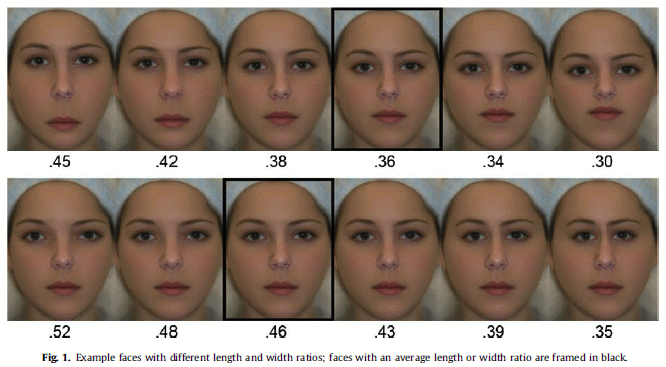 The study reports that the researchers were “surprised to find that the preferences of the volunteers were surprisingly consistent, but with very different results from the well-known Golden Ratio of 0.618 (the reciprocal of 1.618).” The researchers concluded that they had found these two “new golden ratio” proportions that define beauty:
The study reports that the researchers were “surprised to find that the preferences of the volunteers were surprisingly consistent, but with very different results from the well-known Golden Ratio of 0.618 (the reciprocal of 1.618).” The researchers concluded that they had found these two “new golden ratio” proportions that define beauty:
- Vertical facial dimensions – The distance from the eyes to the lips in relation to the that of the hairline to chin, with a ratio of 36% considered the most attractive, and
- Horizontal facial dimensions – The distance between the pupils of the eyes in relation to the width of the face at the eyes, with a ratio of 46% considered the most attractive
The conclusions were flawed in not understanding how the Golden Ratio is found in the human face
This is where the conclusions of the study were flawed. The study in fact actually confirmed that perceptions of beauty are indeed based on the Golden Ratio, 1.618, as illustrated by the photo at the beginning of this article showing a dozen golden ratios. The two “new” golden ratios are reconciled to the true golden ratios below.
The faces selected as most attractive show clear Golden Ratio proportions
- Eyes – The inside and outside corners of the eyes
- Nose – The width of the nose
- Eyebrows – The inside edge of the eyebrows
The face below, judged as most attractive in the study for vertical proportions, illustrates the following facial features based on Golden Ratios of the height of the face:
- Nose – The base of the nose in relation to the distance from the pupils to the chin
- Lips – The center of the lip line in relation to the distance from the pupils to the chin
The “new” golden ratio of 0.46 is easily derived from the true Golden Ratio of 1.618
The “new” golden ratios declared by the study can be easily reconciled to the true Golden Ratio as shown below. The numbers shown on the photo below represent the dimensions in pixels. These dimensions give familiar variations on Phi multiplied by 100 and rounded to two decimals. Phi is the Greek letter Φ used to represent 1.618, the Golden Ratio:
- 38 = Phi to the -2 power (e..g., 1/Φ²)
- 62 = Phi to the -1 power (e.g., 1/Φ or 0.618 multiplied by 100)
- 100 = Phi to the 0 power
- 162 = Phi to the 1 power (e.g., Φ or 1.618 multiplied by 100)
- 200 = 162 + 38
- 224 = 162 + 62
- 262 = Phi to the 2 power (e.g., Φ² or 2.618 multiplied by 100)
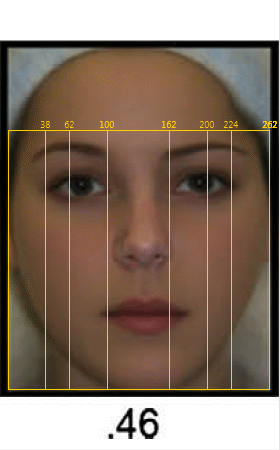 The “new” golden ratio of 0.46 can then be computed from these Phi-based numbers as:
The “new” golden ratio of 0.46 can then be computed from these Phi-based numbers as:
- Position of left pupil, at the midpoint of first golden ratio line at 38 pixels and third golden ratio line at 100 pixels = (38+100)/2 = 69
- Position of right pupil, at the midpoint of fourth golden ratio line at 162 pixels and fifth golden ratio line at 224 pixels = (162+224)/2 = 193
- Distance between the pupils = 193-69 = 124
- “New” golden ratio defined as the distance between the pupils in relation to the width of the face = 124 / 262 = 0.47
The “new” golden ratio of 0.36 is just one element of other key facial dimensions based on true Golden Ratio of 1.618
These dimensions in pixels give familiar variations on phi, rounded to two decimals:
- 62 = Phi to the -1 power (e.g., 1/Φ or 0.618 multiplied by 100, rounded)
- 100 = Phi to the 0 power
- 162 = Phi to the 1 power (e.g., Φ or 1.618 multiplied by 100, rounded)
- 200 = 162 + 38
- 224 = 162 + 62
- 262 = Phi to the 2 power (e.g., Φ² or 2.618 multiplied by 100, rounded)
- 324 = 162 * 2 or 100+224
The “new” golden ratio of 0.36 can thus also be derived from these Phi-based numbers as:
- Position the eyes at the third golden ratio line at 162 pixels
- Position of the lips/teeth at the fifth golden ratio line at 262 pixels
- Distance between the teeth and the chin as 262-162 = 100
- Height of the hairline at 62 pixels to the chin at 324 pixels = 324 – 62 = 262
- “New” golden ratio defined as the distance from the eyes to the lips in relation to the distance of the hairline to the chin = 100 / 262 = 0.38
Does the Golden Ratio define beauty? The search is over, the proof exists and it’s still the Gold Standard
As referenced above, Science Daily quoted the one of the researchers as saying “People have tried and failed to find these ratios since antiquity” and “there was never any proof that the golden ratio was special. As it turns out, it isn’t.” With this article, I hope you can agree that the search is over, the proof exists, the Golden Ratio is still quite special, and now has a completely unbiased scientific study from two major universities to back it up. For more yet on illustration of the impact of the Golden Ratio on beauty, see the Beauty and Face pages.
References:
Pallett, P. M., et al. New ‘‘golden” ratios for facial beauty. Vision Research (2009), doi:10.1016 / j.visres.2009.11.003 (PDF)
http://esciencenews.com/articles/2009/12/16/researchers.discover.new.golden.ratios.female.facial.beauty “Beauty is not only in the eye of the beholder but also in the relationship of the eyes and mouth of the beholden. The distance between a woman’s eyes and the distance between her eyes and her mouth are key factors in determining how attractive she is to others, according to new psychology research from the University of California, San Diego and the University of Toronto. Pamela Pallett and Stephen Link of UC San Diego and Kang Lee of the University of Toronto tested the existence of an ideal facial feature arrangement. They successfully identified the optimal relation between the eyes, the mouth and the edge of the face for individual beauty.”
http://www.sciencedaily.com/releases/2009/12/091216144141.htm “People have tried and failed to find these ratios since antiquity. The ancient Greeks found what they believed was a ‘golden ratio’ — also known as ‘phi’ or the ‘divine proportion’ — and used it in their architecture and art. Some even suggest that Leonardo Da Vinci used the golden ratio when painting his ‘Mona Lisa.’ But there was never any proof that the golden ratio was special. As it turns out, it isn’t. Instead of phi, we showed that average distances between the eyes, mouth and face contour form the true golden ratios,” said Pallett, a post-doctoral fellow in psychology at UC San Diego and also an alumna of the department.
http://www.eurekalert.org/pub_releases/2009-12/uot-rdn121609.php
http://www.nbcnews.com/id/34482178/ns/health-skin_and_beauty/#.UUUBjByG1KK

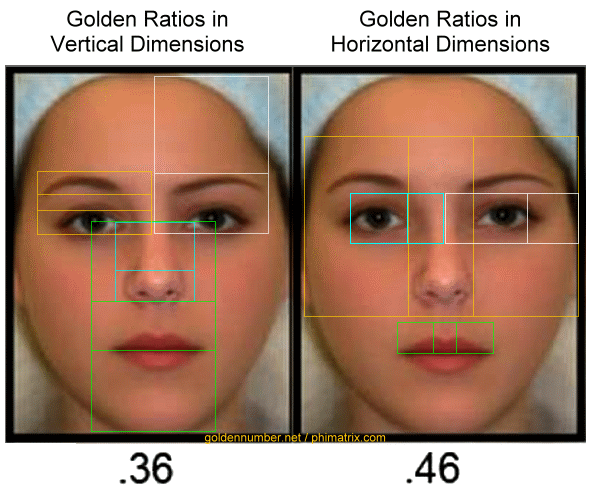
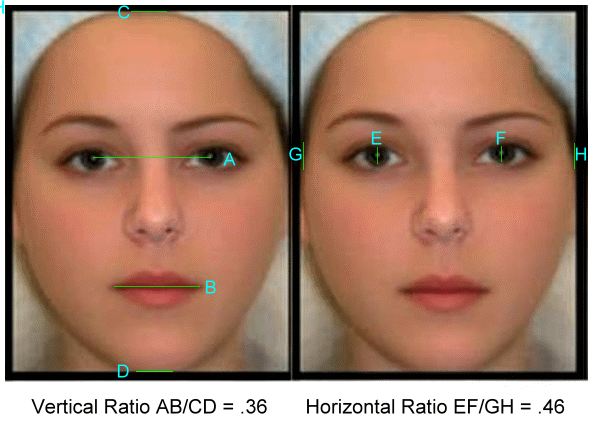
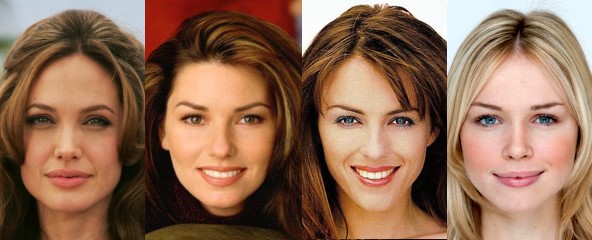
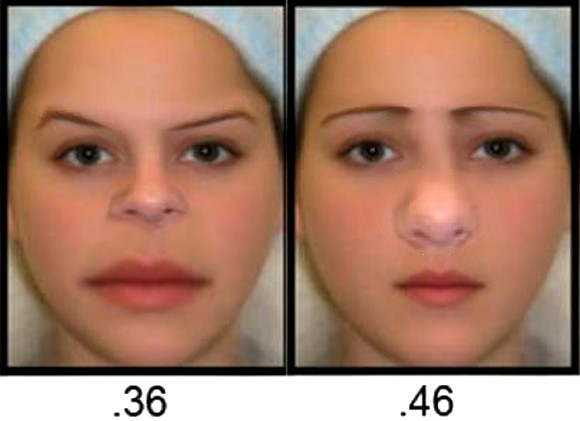
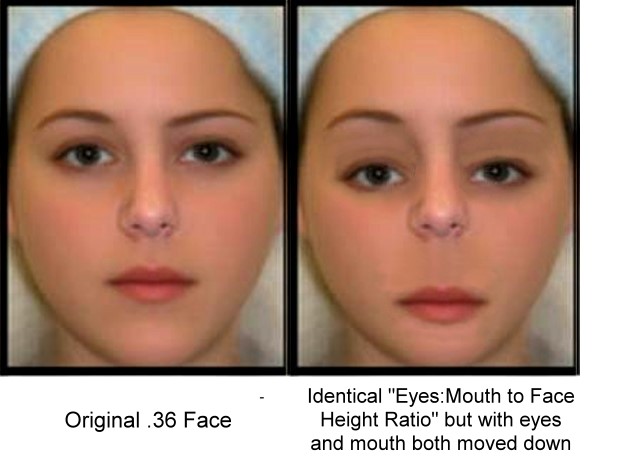
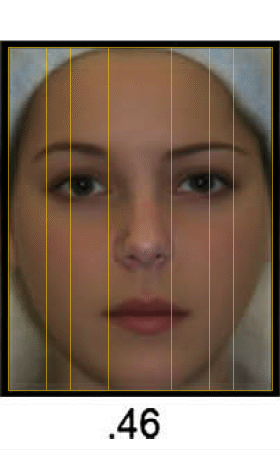
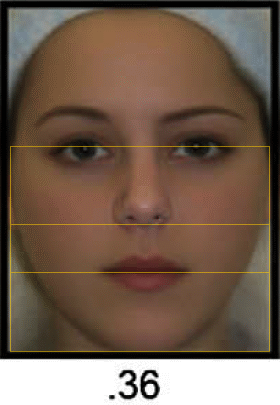
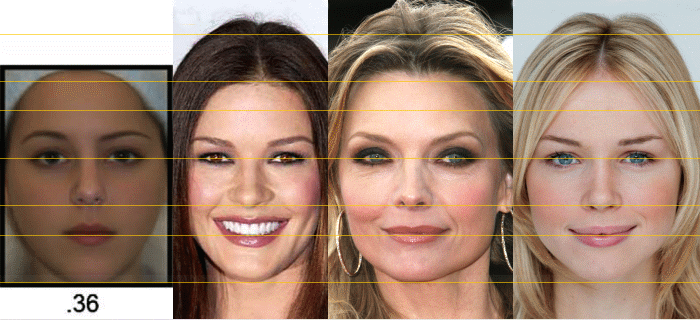
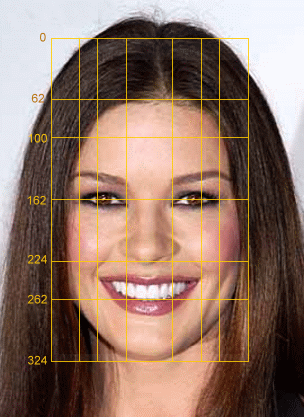


Static proportions are condensate or crystalised forms; for the Dynamical, temporal geometric flow signatures of energy, matter and information that lead to these Static forms, please refer to the Asynsis principle-Constructal law of Design – Form follows Flow:
Cosmomimetic Design in Nature, Consciousness & Culture – Asynsis Principle-Constructal Law Seminar:
Shanghai University-Nantes L’ecole de Design wp.me/p1zCSP-2i via @ASYNSIS
I liked .34 and .43 faces in graph better than the .36 and .46 faces in graph. The .34 and .43 faces just look sexier to me.
I’m more a fan of .38 and .48.
That’s kind of degrading to the other measurements, don’t you agree?
Sexier or prettier is just a number according to this article .
I think beauty is as individual as snowflakes.
If the ranking system was 1-10 any face would fall on the average on 5 with 1 and 10 being picked the least .
What I am saying is that the golden ratio is science but beauty is an art. Isn’t there a common saying that says beauty is in the eye of the beholder ?
Two thoughts: Every face is as unique as snowflakes, so quantifying the proportions that result in most people perceiving a face as beautiful takes nothing away from its uniqueness. People may have individual preferences, but the truth is that some faces are more universally perceived as beautiful than others, and science can help us to measure and understand it.
good for you!! I agree beauty is in the eye of the beholder.
But if physical beauty really IS just in the eye of the beholder, why are so many “eyes of beholders” in agreement on which faces are beautiful and which aren’t so beautiful? See the
examples of beauty ranges in the research of Dr. Stephen Marquardt, inventor of the golden ratio based “beauty mask.” Which one do your eyes behold as most beautiful?
In my Opinion “The Attractive Face” was the most attractive(no pun intended) out of the “face beauty ranges.”
You realize that the Stephen Marquardt “beauty mask” is wrong right? He used statues, paintings and mainly Western fashion models. Which is ridiculous since statues and paintings aren’t real people. And models have different type of facial aesthetics compared to normal women. First of all, almost all the faces which had the Marquardt mask applied to them, never seemed to fit it that well.
(I’m talking about the mask for females, since people tend to use the female mask also on males which makes it two wrongs.)
Either their face is too big or people just cheat by leaving the upper part out on purpose. The noses never seem to fit. The eyebrows seem to be a little too low. The upper part always seems to be above the hairline. The lips are too small. I have seen people trying to Photoshop faces on YouTube while using the Marquardt mask. And the face they Photoshopped started to look like an alien. Even in the examples Marquardt himself uses, the mask seems to fail (usually with the lips, eyebrows and the upperhead area).
It is sad to see that plastic surgeons use the Marquardt mask to force a face to fit in a wrong designed mask. Just look at Hollywood and the amount of people who get a way too small nose for their face.
Does beauty have a formula? I don’t know about that, but I do agree that beautiful faces tend to have certain distances within their face which makes them beautiful. However even those faces seem to differ from each other. So, you can’t really say that there is a one size fit all mask or formula. If you draw a mask you will notice that beautiful people do tend to be slightly off from one another (but not too much) so they can have similar faces, but can still look different.
And personal opinions do definetly matter. For example Asians have a pretty flat face in general, which I personally don’t like that much while Europeans have more depth in their face (higher cheekbones etc). So, even if an Asian fits a mathematical model perfectly I probably won’t like it.
Another important thing that matters is the pictures you use. People don’t realize that if you zoom in your face can change dramatically. So, if anyone is interested in creating their own mask, don’t just use every picture you find. Just look at a pictures of faces taken with a 300 mm lens, and a picture with a 19 mm lens. There is a huge difference between those two.
If I thought the mask was wrong it wouldn’t be on this site. I can tell though that your understanding about Dr. Marquardt’s research is very limited. The application of the mask to statues and paintings is presented only to show that beauty is timeless and has been found in the same facial proportions for centuries. His research, however, was based on the study of hundreds of photos of models whose faces were reviewed for attractiveness by participants in his studies. I know this because I’ve visited him in his office and seen the volumes of work. His mask is also based on years of first hand experience as a highly qualified and successful maxillofacial plastic surgeon and experience as Chief of Facial Imaging at UCLA, and professorships at Loma Linda University as well as at the University of Southern California.
As to individual faces not fitting the mask, no, the mask is a single archetype and not everyone’s face is going to fit every line exactly. It may be too that the applications you’ve seen of the mask were done by amateurs who didn’t fully understand how to apply it. See http://www.beautyanalysis.com/research/evidence/contemporary-beauty/ for beauty examples. Dr. Marquardt recognizes ethnic differences and discusses them at http://www.beautyanalysis.com/beauty-and-you/face-variations/face-variations-ethnic-group/.
You are absolutely right though that it’s important to use photos of faces taken from a proper distance (at least 10 feet), directly perpendicular to the subject, and with a good lens that eliminates optical distortion. You are also right that incorrect application of the mask will result in unnatural, alien-like features. There is one YouTube video of a young man applying the mask to his facial photo and the results are very odd looking. It turns out though that he incorrectlly applied the female mask to his photo. See more at http://www.beautyanalysis.com/featured/others-using-beauty-mask/.
There’s nothing “sad” about this and no one with any competence is “forcing a face to fit.” It’s a very good tool that has been shown to produce very favorable results, but only in the skilled hands of those who truly understand it and know how to apply it.
I think most of us could agree that this study is as non-important as defining the perfect strawberry. Not one of us would want to live with a “perfect” woman who was rotten to the core in her personality. However…. that disclaimer out of the way, it’s super interesting to me that these trends (TRENDS, people. OK? Relax.) in preferences exist across all people, and even more interesting that they have a mathematical basis. I’m a stock trader, and I also study the Golden Ratio. How weird is it that these ratios would pop up in such disparate places?! It’s worth studying, because it’s dang interesting! But don’t go get plastic surgery over it. I don’t even HAVE a hairline, so don’t lose the forest for the trees!
It may be true that beauty is only skin deep, but that hardly reduces a quest to understand the nature of human facial beauty, and its impact on the human experience, to the level of attractive fruit. Compare the number of beautiful faces you’ve seen on magazines to the number of beautiful strawberries. And consider the emotional response you have to a beautiful face versus that of a perfect strawberry. As you note though, it is worth studying because it it interesting, and pops up in a rather amazing number of places.
I like the idea of the “new” Golden Ratio. This being said however, there are still its faults. I honestly find it hilarious that “pretty” people just don’t measure up!
and Diane Kruger?
I thought that 34 and 48 were more attractiive…..
If everyone’s face followed the “golden ratio mask’s” guidelines, wouldn’t everyone look the same? (with a few facial shape exceptions.)
No, not at all. The golden ratio guidelines apply to major facial markers that define the overall structure of the face. There are still endless variations in the shapes of the various facial components (eyes, nose, lips, eye brows, etc.) to create infinite individual uniqueness. As an example, see the five famous personalities shown at https://www.goldennumber.net/golden-ratio-myth/. Their eye-lip-chin measurements are identical but they really look nothing alike.
And don’t forget, a biological basis like human face and body, nautilus spiral shell, and another living thinks are never fit perfecly with a geometrical basis like a pentagon, decagon, “Phi” spiral, etc even though in the rare case a biological basis can “quite fit” rougly 95% with a geometrical measurement basis.
I’ve been sculptor of human figure for 40 years, mostly I create human faces and figures from clay and wax.
when something “looks off” I check the math. 1.62 is magic, so magic that I made several pairs of dividers that mechanically create Phi proportions between three points. so I can “phi up” or Phi down” any measure.
Also the spiral or spiral sections created by 1.62 are great (like nautilus shell) these spirall sections create beautiful jaw lines, etc.
In closing, perfection is not beauty, perfect symetry is not beauty. Its best to come close to golden proportion and symetry, but then “break the rule” a little, to give your creation a little assymetry and character…….then it is more human, less than perfect as we all are.
my sculpture at: http://www.billhopen.com
Just wanted to say “thanks” for sharing your comments. Your mastery of your art is obvious from the images of your sculptures on your web site. Your comments on the balance of perfection and imperfection in beauty are insightful, especially given the attention to this kind of detail that your experience as a sculptor has given you.
the faces with different proportions are given actually morphed, otherwise these “intentionally” crafted ugly is not possible naturally, the fractal algorithm follows specific rules with horizontal and vertical proportions as well.
we cant say that this is vertical ratio and horizontal ratio totally out of sync, even the shape of nose has to do with the ratio.
better would have been if real images were used to defy the golden rule.
I am trying to find out the shape of face like circle, rectangle , oval , diamond also type of eyes closeset eyes ,
downturned eyes , Deep Set eyes or almond eyes and shape of lips thin lips or drooping corners etc from a image , i got the edge points of face , eyes , lips can i apply any calculation from golden ratio to find out above results PLease Reply ……
Supermodel Magazine has harassed my life. Back then, when I had just an oval face, no one looked like me, but Now EVERYONE DOES!!!!! And Everyone has the same face just as I do in a Magazine!!!!!!!! My face isn’t top-heavy, and my jaw is upright with a fairly short nose. I am The Golden Ratio for The Caucasian Standard even for just being an Asian!!!!!!!!
how to add multiple grids in one pic in phimatrix?
To get multiple grids, just launch multiple instances of PhiMatrix. Each will appear with its own control window. On the PC, just click the same PhiMatrix desktop icon again and again. On the Mac, copy and paste multiple instances of PhiMatrix app in the Applications folder.
there is some truth to the ratio but you are going overboard and trying to prove it by hook or crook in every measurement you make. not really!! take it easy and don’t start praying to it like people pray to god and prove god by hook or crook. keep an open mind or your will make a religion out of it
There is no intent to prove God’s existence with this. That is a matter of faith, not proof. It just shows the proportions that appear rather easily when using some of the most obvious facial markers. No need to use every hook and crook.
show me studies that people who meet these ratios are also considered the most attractive by blinded evaluators across the globe? i dont see many and the way you tried hard to show that the london study was following your measurements shows you are getting a bit fanatical here. your book goes on with these ratios to other organisms as if there was a hidden hand of god or something in the cosmos about these ratios.
So exactly how would a blind evaluator assess attractiveness? By touch? Re the presentation in my book, the best evidence is that the composite facial images compiled from 50 different subjects align very accurately with the golden ratio proportions I’ve identified in key facial markers. These composite facial images represent the averaged face of more than 50 individual faces, well enough for statistical significance, and the averaged faces align more closely to golden ratio proportions than just about any individual’s face. This demonstrates that the typical or archetype human face has golden ratio proportions. There’s nothing fanatical about this, any more than observing that the orbits of the planets around the Sun share common mathematical relationships. It’s based on measurements and data. The golden ratio is expressed in facial proportions of certain other organisms as well, so there is likely a common principle at work. Whether it’s the hidden hand of God being revealed or “something in the cosmos” is a further study that we should all pursue and contemplate with an open mind and heart.
You chose some relatively very old women to test your hypotheses against.. :/
There are a range of ages evaluated, in the group on this page and elsewhere on the site. The key golden ratios are based on skeletal structures that do not change in adults, so a few years and a wrinkle or two doesn’t change the basic proportions. These woman are all very young looking as well. My hypothesis was best validated in the research I did for my book, in which I used composite facial images of up to 50 individuals to get a statistically valid result. These composite images aligned to the golden ratio proportions better than any individual I’ve ever analyzed. See https://bit.ly/goldenratiobook and go down the page to see an example.